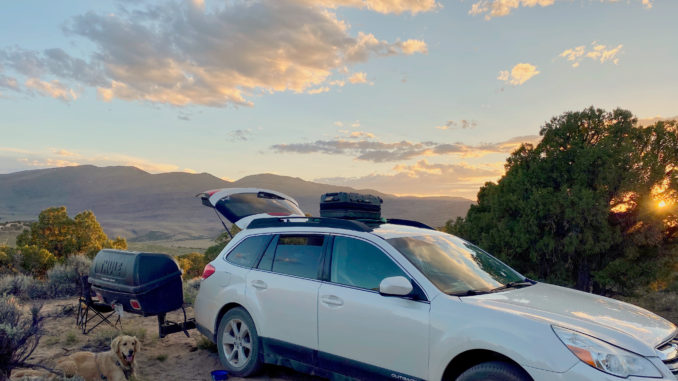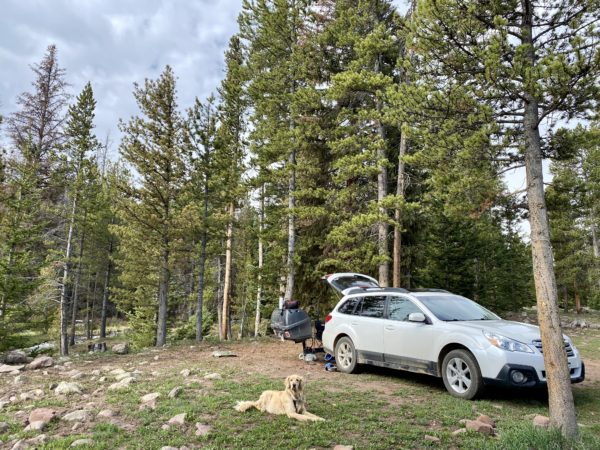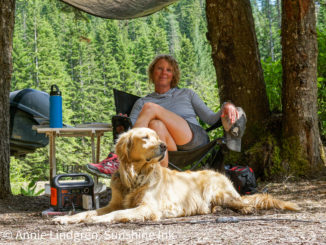
By Annie Lindgren
Dispersed camping is free camping found along roads through public lands. National Forest and Bureau of Land Management (BLM) lands pretty well always have dispersed camping. Some other types of public lands do as well, like Wilderness and Wildlife Preservation areas. These public lands have signs at the entrances, letting you know the rules, restrictions, and dangers, and posting a map for later use (if you take a picture of it). This information, which is essential to take note of for safety and the sake of following the rules, can also be found online.
Where to Camp
Dispersed camping areas have stay limits that vary based on the land rules, but that tends to fall within the 10-16 day limit range. You are only allowed to camp on established sites, to help preserve the landscape. Established sites often have roads leading to them with padded down spaces for vehicles to park and tents to stand, fire pits, and whatever seating those before have found to set up. Signs posted alert you if camping is not allowed. With all the beetle kill in Colorado forest, check the trees in the area where you plan to camp, and avoid camping near dead trees that could fall in a storm.
There are a lot of great places to find dispersed camping in Northern Colorado. Arapaho-Roosevelt National Forest, Pawnee National Grassland, and Medicine Bow-Routt National Forest are full of spaces. A Colorado Recreation map is good to have, as it shows all the public land areas and the roads that go through them. Cell service can be hard to come by, so paper maps are handy.
Wildlife Safety
Know what types of animals or plants you may encounter and how to manage any risk associated with that. The entryway signs of the area will tell you what to watch out for, and how to remain safe in its presence. Mountain lions, rattlesnakes, rodent pests, moose, and bears all take special consideration when it comes to keeping food, dogs, and humans safe. Don’t let these animals discourage you from getting out. If you respect their space and don’t give them a reason to enter your camp, they will respect your space.
It is vital not to leave food or trash out unattended in bear country. Keep these things in enclosed spaces that the bears can’t get to (like a vehicle), or hang them in a bear bag from a tree. Never leave food in the tent. If a bear does get to the food, that bear often will have to be euthanized later, and you will likely need to replace whatever got destroyed in the process.
Water
Water can be carried in or obtained from nature. Great camp spots have water sources running through them. You should always sanitize the water you plan to consume. There are various filter options available, or you can boil water or use chemical treatment.
Bathroom
Potty responsibly in the woods. Bring a shovel to dig a hole for #2, at least 6 inches deep. Don’t do the duty near a water source, as that is how water sources become contaminated. Be mindful of where your dog is doing the duty. Toss, burn, or bury your toilet paper, so the forest is not filled with little white flags. Ladies learning to pee in the woods can use logs, boulders, and trees to help balance when squatting.
Pets
Most dogs love the great outdoors, but many things in the forest can hurt them. A dog without a healthy respect for big animals can result in said big animals chasing your dog back to camp. It is best to keep your canine pal tied or on a leash when not carefully attended. You are a long way from a vet if disaster strikes. Bring a first aid kit that includes wound care and Benadryl. Check them for ticks and consider putting them indoors if they are being harassed by biting insects.
Fire
Know about the fire danger of the area. If there is a fire ban in effect, don’t have a fire. If you plan to shoot guns in the woods, make sure it is allowed, and that there is no way that a stray bullet will go sailing through other campsites. If you can have a fire, the forest tends to be amply full firewood. Bring a bucket so that you can make sure your fire is entirely out before bedtime.
What to Pack
- A space to sleep in, bedding that will keep you warm, and a sleeping pad for comfortable slumber.
- Food and ways to prepare and administer it.
- Lighting for after dark.
- Safety and first aid items, in case something goes wrong.
- A shovel, toilet paper, and trash bag.
- Clothes and layers that will keep you comfortable and dry.
- Bear mace if you are in bear country.
- Bug spray, sunscreen, and medications.
- Water and water purification.
- Chairs to seat comfortably, and whatever other comfort items your space allows.
- Tools to build a fire if you plan to have one.
Dispersed camping is a wonderful way to get out in nature, without being far from your vehicle and the conveniences it provides. It is free, other than the fuel it takes to get there. With some planning, it can be a safe, affordable, and rewarding experience.

Support Northern Colorado Journalism
Show your support for North Forty News by helping us produce more content. It's a kind and simple gesture that will help us continue to bring more content to you.
BONUS - Donors get a link in their receipt to sign up for our once-per-week instant text messaging alert. Get your e-copy of North Forty News the moment it is released!
Click to Donate
